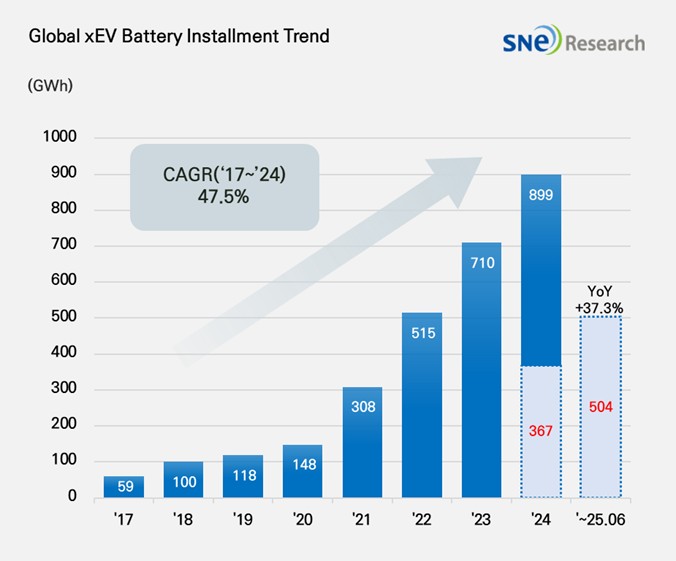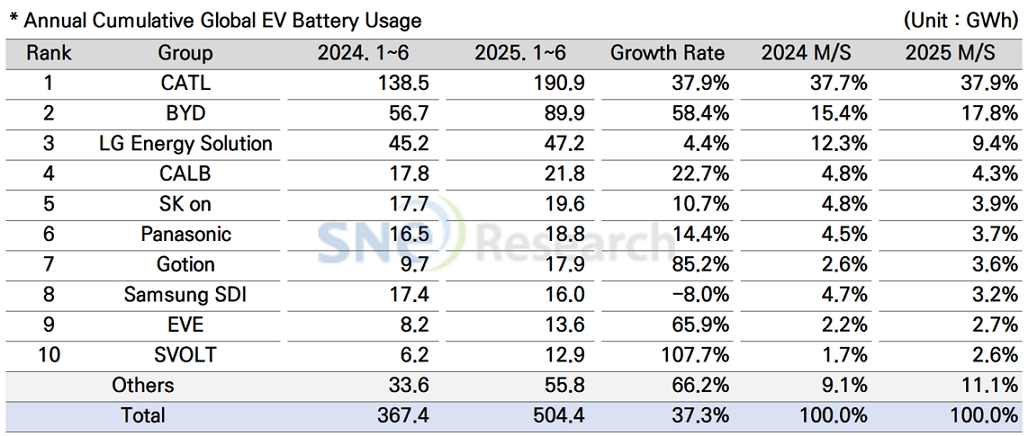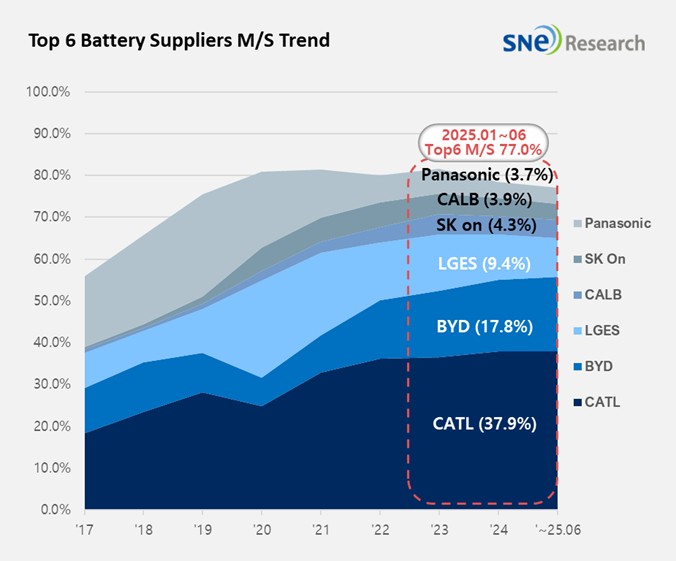From Jan to June in 2025, Global EV
Battery Usage
Posted 504.4GWh, a 37.3% YoY Growth
- From Jan to June
in 2025, K-trio’s M/S recorded 16.4%, a 5.4% YoY decline.
From Jan to
June in 2025, the amount of energy held by batteries for electric vehicles (EV,
PHEV, HEV) registered worldwide was approximately 504.4GWh, a 37.3% YoY growth.

(Source: 2025 July Global Monthly EV and Battery Monthly Tracker, SNE Research)
The combined market shares of LG Energy Solution, SK On, and Samsung SDI in global electric vehicle battery usage from Jan to June 2025 posted 16.4%, a 5.4%p decline from the same period last year. LG Energy Solution remained 3rd on the list with 4.4%(47.2GWh) YoY growth. While SK On ranked 5th with a 10.7%(19.6GWh) growth, Samsung SDI posted an 8.0%(16.0GWh) degrowth.

(Source: 2025 July Global Monthly EV and Battery Monthly Tracker, SNE Research)
If we look at the usage of battery made by the K-trio in terms of the sales volume of models, Samsung SDI’s battery was mainly supplied to BMW, Audi, and Rivian. BMW has Samsung SDI’s batteries in its major electrified models such as i4, i5, i7, and iX, and among them, the best-selling i4 saw a decline in sales, which has led to a 5.0% YoY decrease in the usage of batteries sold to BMW. Although Rivian recorded stable saled of R1S and R1T in the US, the newly launched standard range trim, to which Gotion’s LFP batteries are installed, has lowered the share of batteries supplied by Samsung SDI to Rivian. On the other hand, as Audi started selling Q6 e-Tron, built on the PPE platform, the usage of batteries recorded an 8.8% YoY growth.
SK On’s battery was installed to electric vehicles made by Hyundai Motor Group, Mercedes-Benz, Ford and Volkswagen. Hyundai Motor Group saw a gradual recovery in sales of IONIQ 5 and EV 6 after facelift, and steady sales of VW ID.4 and ID.7 also contributed to an increase in the usage of batteries made by SK On. On the other hand, a slowdown in sales of Ford’s F-150 Lightning, to which large-capacity batteries are installed, has led to a 13.4% YoY decrease in the usage of batteries supplied to Ford.
LG Energy Solution’s battery was mainly used by Tesla, Chevrolet, Kia, and Volkswagen. In the case of Tesla, the declining sales of models equipped with LG Energy Solution’s batteries led to a 28.9% YoY decrease in Tesla’s usage of LG Energy Solution’s batteries. On the other hand, favorable sales of KIA EV3 in the global market and expanded sales of Equinox, Blazer, and Silverado EV, to which the Ultium platform was applied, in the North American market were a major drive behind the growth of usage of batteries made by LG Energy Solution.
Panasonic, which mainly supplies batteries to Tesla, ranked 6th on the list with a battery usage of 18.8GWh. Panasonic has been accelerating the reshuffling of supply chain in response to the recently fortified US tariffs on the Chinese batteries and raw materials. To be specific, Panasonic is trying to lower its dependency on the Chinese materials, expand the procurement of local materials, and secure new material sources in order to increase the stability in battery production. These efforts are expected to lay a significant foundation for recovery in the usage of batteries made by Panasonic and maintaining its market share in the North American market.
CATL remained top in the global battery usage ranking, posting a 37.9%(190.9GWh) YoY growth. Key Chinese OEMs such as ZEEKR, AITO, Li Auto, and Xiaomi adopted CATL’s batteries, and many global major OEMs, including Tesla, BMW, Mercedes-Benz, and Volkswagen, are also using CATL’s batteries.
BYD ranked 2nd on the list with a growth rate of 58.4%(89.9GWh). BYD, which manufactures both batteries and electric vehicles (BEV+PHEV) in-house, has been expanding sales of various models based on its strong price competitiveness. It has been solidifying its presence not only in the Chinese domestic market but also in the global market. In particular, BYD showed a notable expansion in the European market. In the 1st quarter of this year, the usage of BYD batteries in Europe recorded 6.0GWh, a 313.4% YoY increase.

(Source: 2025 July Global Monthly EV and Battery Monthly Tracker, SNE Research)
The global battery market is rapidly undergoing a supply chain reorganization and tightening of regulations, particularly across the United States and Europe. In the U.S., the One Big Beautiful Bill Act (OBBBA) has emerged as a major policy development, significantly scaling back clean energy tax incentives previously granted under the Inflation Reduction Act (IRA). Notably, the OBBBA introduces the Foreign Entity of Concern (FEOC) rule, which restricts tax credit eligibility for batteries and raw materials linked to certain countries—especially China. This creates profound ripple effects throughout the electric vehicle (EV) and battery industries. In response, South Korean battery manufacturers are pursuing mid- to long-term strategies such as increasing local production capacity in North America, reducing dependence on Chinese raw materials, and strengthening non-China-aligned supply chains. These moves are interpreted as proactive responses not only to the IRA and AMPC (Advanced Manufacturing Production Credit), but also to a more demanding regulatory landscape. Simultaneously, Europe is intensifying efforts to secure supply chain resilience through local production incentives and strategic stockpiling initiatives. Chinese battery companies are also accelerating local plant construction in the region, prompting a swift shift in competitive dynamics. Amid this dual pressure of geopolitical risk and heightened supply chain control, battery makers now face a critical turning point; one that demands not only superior technology, but also independence in sourcing and strategic agility across global markets.
Based on battery
installation for xEV registered during the relevant period.




